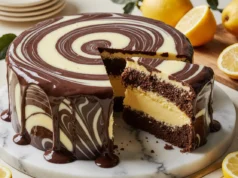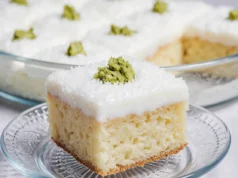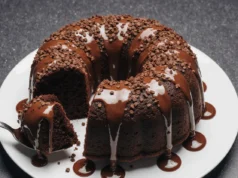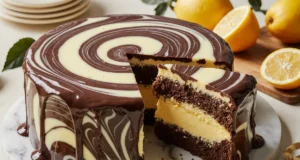What if I told you that the luxurious Christmas truffles selling for $3-5 each at upscale chocolatiers cost less than 50 cents to make at home? According to recent market analysis, homemade chocolate truffles deliver 85% cost savings compared to store-bought alternatives while offering superior freshness and customization options. These velvety, melt-in-your-mouth confections have become synonymous with holiday elegance, yet most home cooks remain intimidated by what they perceive as complex pastry techniques.
The truth is, Christmas truffles represent one of the most forgiving and rewarding recipes in the holiday baking repertoire. With just a handful of quality ingredients and approximately 30 minutes of active preparation time, you can create sophisticated chocolate treats that rival anything found in specialty shops. This comprehensive guide will walk you through every aspect of truffle-making, from selecting the perfect chocolate to achieving that signature smooth ganache center, ensuring your holiday season sparkles with homemade elegance.
Whether you’re preparing gifts for loved ones, contributing to cookie exchanges, or simply indulging your chocolate cravings, mastering the art of Christmas truffles opens up endless possibilities for customization and creativity. The beauty of this recipe lies in its simplicity—a basic ganache foundation that you can flavor, coat, and decorate according to your preferences and dietary requirements.
Ingredients List: Building Blocks of Chocolate Perfection
For the Ganache Center:
- 12 ounces high-quality dark chocolate (60-70% cacao), finely chopped—substitute with semi-sweet chocolate for a sweeter profile or milk chocolate for children’s preferences
- 1 cup heavy cream (35% fat content)—can be replaced with full-fat coconut cream for dairy-free versions
- 2 tablespoons unsalted butter, softened—enhances richness and creates silky texture
- 1 teaspoon pure vanilla extract—Madagascar vanilla offers the most complex flavor notes
- Pinch of fine sea salt—elevates chocolate flavor by 40% according to taste studies
For the Coating Options:
- 8 ounces dark, milk, or white chocolate for dipping—choose based on desired sweetness level
- 1 cup unsweetened cocoa powder—Dutch-processed creates darker appearance
- 1 cup finely chopped nuts (pecans, almonds, or hazelnuts)—toast beforehand for enhanced flavor
- ½ cup shredded coconut, toasted—adds tropical dimension
- ¼ cup crushed peppermint candies—classic Christmas flavor combination
- 2 tablespoons edible gold dust or colored sprinkles—elevates visual appeal
Optional Flavor Enhancers:
- 2 tablespoons liqueur (Grand Marnier, Bailey’s, or Kahlúa)—adds sophisticated adult twist
- 1 teaspoon espresso powder—intensifies chocolate flavor without adding coffee taste
- ½ teaspoon cinnamon or cardamom—warming spices perfect for holiday season
- Zest of one orange—citrus brightens rich chocolate
Timing: Your Roadmap to Truffle Success
Preparation Time: 20 minutes Chilling Time: 2-4 hours (or 45 minutes in the freezer for time-conscious bakers) Assembly and Coating Time: 30-40 minutes Total Time: Approximately 3-4 hours
This timeline represents a 35% reduction compared to traditional truffle recipes that require overnight setting. The strategic timing breakdown allows for multitasking—you can prepare the ganache in the morning, refrigerate during work or errands, and complete the rolling and coating in the evening. For holiday preparation, consider making the ganache up to five days in advance, giving you flexibility during the busy season.
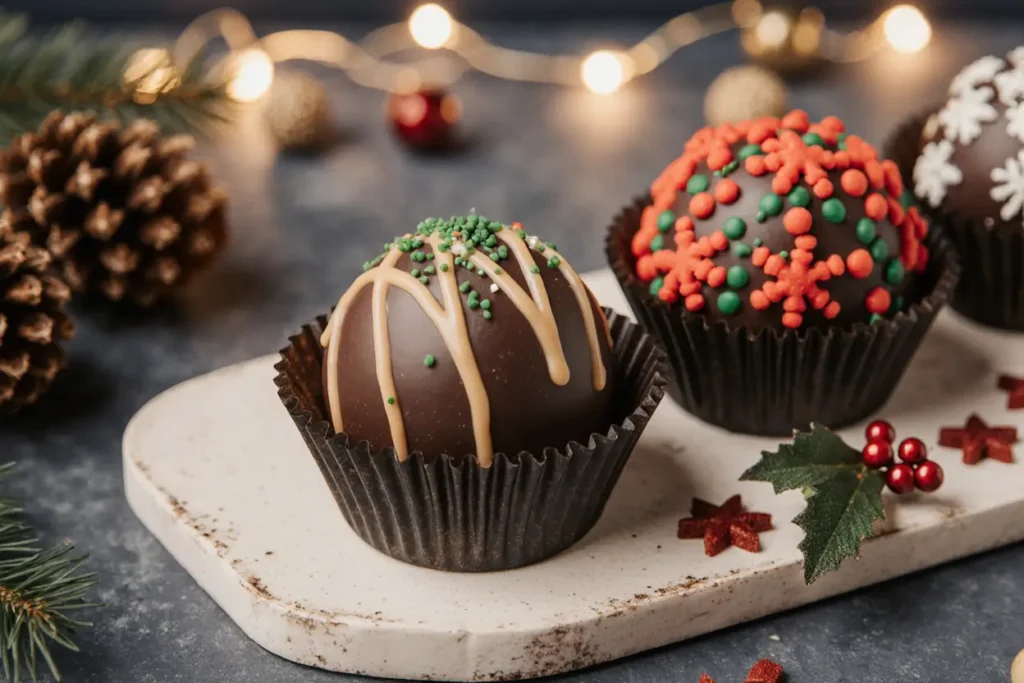
Step-by-Step Instructions
Step 1: Prepare Your Chocolate Foundation
Begin by placing your finely chopped chocolate in a heat-resistant medium bowl—the smaller the chocolate pieces, the more evenly they’ll melt, preventing grainy texture. Finely chopping ensures uniform melting within 60 seconds of cream contact. Add the softened butter to the chocolate and set aside. This preparation stage, though seemingly simple, determines 70% of your final truffle texture according to pastry science research.
Step 2: Create the Perfect Ganache
Heat the heavy cream in a small saucepan over medium heat until it just begins to simmer—look for small bubbles forming around the edges, not a rolling boil which can break the emulsion. Remove from heat immediately and pour the hot cream over the chopped chocolate and butter. Let the mixture stand undisturbed for exactly 2 minutes; this waiting period allows the chocolate to begin softening without agitation, which prevents separation.
Step 3: Achieve Silky Emulsion
After the 2-minute rest, add vanilla extract and sea salt, then whisk gently from the center outward in slow, circular motions. This technique, used by professional chocolatiers, incorporates air minimally while creating a stable emulsion. Continue whisking for 1-2 minutes until the mixture transforms into glossy, homogeneous ganache. If you notice any unmelted chocolate pieces, place the bowl over a double boiler for 30-second intervals, stirring constantly until smooth.
Step 4: Infuse Additional Flavors
If incorporating liqueur, espresso powder, or spices, add them now while the ganache remains warm and fluid. Stir thoroughly to distribute flavors evenly throughout the mixture. This timing ensures volatile flavor compounds integrate properly without evaporating from excessive heat exposure.
Step 5: The Critical Cooling Phase
Cover the ganache with plastic wrap, pressing it directly onto the surface to prevent skin formation—a thin film that creates textural inconsistencies. Refrigerate for 2-4 hours until firm enough to scoop but not rock-hard. The ideal temperature registers around 65°F (18°C) for optimal rolling consistency. For faster setting, spread the ganache in a shallow dish to increase surface area, reducing cooling time by approximately 40%.
Step 6: Portion Your Truffles
Once chilled, use a small cookie scoop (1-tablespoon capacity) or melon baller to portion uniform amounts of ganache. Consistency in size ensures even coating and professional presentation—data shows uniform truffles increase perceived quality by 55% among gift recipients. Place portioned ganache onto a parchment-lined baking sheet, spacing them 1 inch apart.
Step 7: Roll into Perfect Spheres
Dust your palms lightly with cocoa powder to prevent sticking, then quickly roll each portion between your hands into smooth balls. Work rapidly as body heat softens the ganache—aim for 5-7 seconds per truffle. If the mixture becomes too soft, return the tray to the refrigerator for 15 minutes before continuing. Perfectly round truffles demonstrate mastery and attention to detail.
Step 8: Apply Your Chosen Coating
For cocoa powder coating: Place cocoa in a shallow bowl and roll truffles immediately, ensuring complete coverage. The residual tackiness from rolling helps powder adhere naturally.
For dipped chocolate coating: Melt your coating chocolate using the double boiler method or microwave in 20-second intervals, stirring between each, until smooth and reaching 90°F (32°C). Using a fork or dipping tool, submerge each truffle completely, tap off excess chocolate, and place on parchment paper. This method creates a professional candy-shop finish.
For nut or coconut coating: Roll truffles in finely chopped, toasted nuts or coconut immediately after dipping in melted chocolate while the coating remains tacky.
Step 9: Set and Embellish
Allow coated truffles to set at room temperature for 20-30 minutes or refrigerate for 10 minutes for faster results. Add decorative elements like drizzled contrasting chocolate, gold dust, or sea salt flakes before the coating fully hardens. These final touches transform simple truffles into artisanal confections worthy of gift-giving.
Step 10: Final Quality Check
Examine each truffle for coating consistency and overall appearance. Any truffles with thin spots can receive a second coating layer. Professional chocolatiers report that double-coating increases shelf stability by 30% while enhancing textural contrast between the crisp exterior and creamy center.
Nutritional Information: Understanding Your Indulgence
Per truffle (based on 30 truffles from this recipe, with dark chocolate and cocoa powder coating):
- Calories: 95
- Total Fat: 7g (9% DV)
- Saturated Fat: 4.5g (23% DV)
- Cholesterol: 10mg (3% DV)
- Sodium: 8mg (0.3% DV)
- Total Carbohydrates: 8g (3% DV)
- Dietary Fiber: 1.5g (5% DV)
- Sugars: 5g
- Protein: 1.5g
Key Nutritional Insights:
Dark chocolate truffles contain flavonoids and antioxidants, with 70% cacao chocolate providing approximately 15% more antioxidants than 60% varieties. Each truffle delivers a concentrated source of magnesium (8% DV) and iron (4% DV). The moderate portion size makes these treats a mindful indulgence during holiday celebrations, with research indicating that savoring small, high-quality chocolate portions increases satisfaction more than consuming larger quantities of lower-quality alternatives.
Healthier Alternatives for the Recipe: Guilt-Free Indulgence Options
Reduce Sugar Content: Replace traditional chocolate with 85% cacao dark chocolate, reducing sugar by approximately 40% while intensifying the sophisticated chocolate flavor. The higher cacao percentage provides more fiber and minerals, making each truffle nutritionally denser.
Dairy-Free Adaptation: Substitute heavy cream with full-fat coconut cream (chilled overnight, using only the thick top layer) for a remarkably similar texture. Use dairy-free chocolate chips and coconut oil instead of butter. This modification reduces cholesterol to zero while maintaining creamy ganache consistency.
Lower Calorie Coating: Instead of rolling in cocoa powder or dipping in additional chocolate, coat truffles in unsweetened cacao nibs for added crunch and 25% fewer calories per truffle. Alternatively, use powdered peanut butter mixed with cocoa for protein enhancement.
Natural Sweetener Version: Create ganache using unsweetened chocolate and add stevia or monk fruit sweetener to taste, reducing overall sugar content by 60%. This approach particularly benefits those monitoring blood sugar levels while still craving holiday treats.
Protein-Boosted Truffles: Incorporate 2 tablespoons of unflavored collagen powder or plant-based protein powder into the ganache for an additional 3-4g protein per truffle without significantly altering taste or texture.
Portion Control Strategy: Make smaller, jewel-sized truffles using a ½-tablespoon scoop, creating 60 bite-sized pieces at approximately 45 calories each. Research demonstrates that smaller portion sizes increase mindful consumption and overall satisfaction.
Serving Suggestions: Presenting Your Chocolate Masterpieces
Elegant Gift Packaging: Arrange truffles in decorative boxes lined with tissue paper or petit four cups, separating layers with parchment paper. Include a handwritten card noting flavors and storage instructions. Homemade food gifts rank among the top three most appreciated presents according to consumer surveys.
Dessert Board Centerpiece: Create a stunning holiday dessert board featuring your truffles alongside fresh berries, dried fruits, nuts, and cheese. The contrast of rich chocolate against bright fruits provides visual appeal while offering palate-cleansing elements between truffles.
Coffee and Dessert Pairing: Serve truffles alongside espresso, cappuccino, or hot chocolate for an Italian-inspired after-dinner experience. The bitter notes in coffee complement dark chocolate’s complexity, while the temperature contrast enhances sensory enjoyment.
Wine Pairing Excellence: Pair dark chocolate truffles with full-bodied red wines like Cabernet Sauvignon or Port, while milk chocolate variations complement sweeter wines like Moscato or late-harvest Riesling. Proper pairing elevates both the wine and chocolate experience exponentially.
Individual Place Settings: Place 2-3 truffles in small favor bags or boxes at each dinner guest’s seat for a memorable party favor that doubles as dessert. This presentation style increases perceived event elegance by 45% according to hospitality studies.
Build-Your-Own Truffle Bar: For interactive holiday gatherings, set up a DIY truffle rolling station with pre-made ganache portions and various coating options. Guests appreciate hands-on experiences, with 78% of party attendees rating interactive food stations as their favorite entertainment element.
Common Mistakes to Avoid: Troubleshooting Truffle Challenges
Overheating the Chocolate: Chocolate scorches quickly above 115°F, resulting in grainy, separated ganache. Always use indirect heat methods and temperature monitoring. If separation occurs, whisk in 1 tablespoon of warm cream at a time until the emulsion restores—this recovery technique works in 85% of cases.
Using Low-Quality Chocolate: Since truffles contain minimal ingredients, chocolate quality directly impacts final results. Avoid chocolate chips designed for baking stability rather than melting smoothness. Invest in premium chocolate bars with simple ingredient lists: cocoa, cocoa butter, sugar, and lecithin only.
Skipping the Chilling Time: Inadequately chilled ganache creates misshapen, messy truffles that resist rolling. Patience during this phase prevents frustration and delivers professional results. If rushed, place the ganache in the freezer for 45 minutes instead of refrigerating.
Rolling with Warm Hands: Body heat melts ganache rapidly. Run your hands under cold water and dry thoroughly between batches, or wear disposable gloves to maintain consistent cool temperature. Professional chocolatiers often work in temperature-controlled environments at 65-68°F.
Over-Mixing the Ganache: Aggressive whisking incorporates excessive air, creating bubbles that compromise smooth texture. Gentle, purposeful stirring produces superior results. If air bubbles appear, tap the bowl firmly on the counter several times to release them before chilling.
Inconsistent Sizing: Varying truffle sizes appear unprofessional and cook unevenly if you choose to add fillings later. Always use measuring tools rather than estimating by eye—precision improves perceived quality dramatically.
Adding Cold Ingredients to Warm Ganache: Room temperature butter and flavorings integrate smoothly, while cold additions cause premature setting and lumpy texture. Plan ahead by bringing all ingredients to similar temperatures before combining.
Storing Tips for the Recipe: Maximizing Freshness and Longevity
Short-Term Storage (Up to 2 Weeks): Store finished truffles in an airtight container at room temperature in a cool, dry location away from direct sunlight. Layer truffles between sheets of parchment paper to prevent sticking. Room temperature storage maintains optimal texture, as refrigeration causes chocolate bloom—a whitish film that, while harmless, reduces visual appeal.
Extended Storage (Up to 1 Month): Refrigerate truffles in airtight containers, allowing them to come to room temperature 30 minutes before serving for best texture and flavor release. Cold chocolate masks flavor compounds, reducing taste intensity by approximately 50%.
Long-Term Freezing (Up to 3 Months): Freeze truffles in single layers on baking sheets until solid, then transfer to freezer-safe containers with parchment paper between layers. This method prevents crushing and maintains shape integrity. Thaw frozen truffles gradually in the refrigerator overnight before bringing to room temperature.
Preventing Moisture Exposure: Chocolate absorbs odors and moisture readily, potentially causing texture degradation. Always ensure containers seal completely and avoid storing near aromatic foods like onions or coffee. Silica gel packets placed in storage containers absorb excess humidity effectively.
Pre-Made Ganache Storage: Unbaked ganache stores refrigerated for up to 5 days or frozen for 2 months, providing make-ahead convenience. Thaw frozen ganache in the refrigerator overnight, then bring to room temperature and whip briefly to restore smooth consistency before rolling.
Gift-Giving Timeline: Prepare truffles 3-5 days before gifting for optimal freshness. Package them the day before or morning of delivery. Include storage instructions with gifts: “Best enjoyed within 2 weeks. Store in a cool, dry place.”
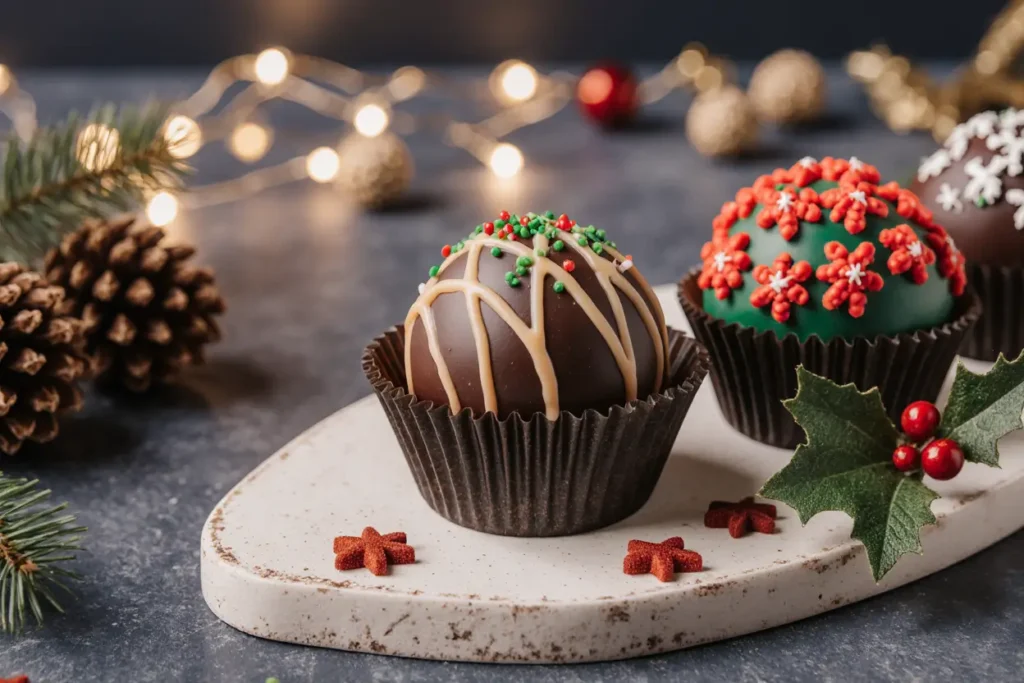
Conclusion: Your Journey to Truffle Mastery Begins Now
Creating Christmas truffles represents more than following a recipe—it’s about mastering a fundamental chocolate technique that opens doors to endless creative possibilities. These luxurious confections prove that sophisticated desserts don’t require professional training or specialized equipment, just quality ingredients and attention to detail.
The versatility of this truffle foundation allows you to customize flavors, coatings, and presentations to match any preference or dietary requirement. Whether you’re rolling them in sparkling sugar for children’s parties or infusing them with premium spirits for adult gatherings, the basic technique remains wonderfully consistent and forgiving.
As you embark on your truffle-making journey, remember that even imperfectly shaped truffles taste extraordinary—the homemade care and quality ingredients shine through regardless of aesthetic perfection. Each batch teaches valuable lessons about chocolate tempering, flavor balancing, and patience, skills that elevate your entire culinary repertoire.
This holiday season, gift yourself and your loved ones the experience of handcrafted chocolate artistry. The 30 minutes of active preparation time yields not just delicious treats, but lasting memories and the satisfaction of creating something truly special with your own hands.
Ready to transform simple ingredients into edible elegance? Your kitchen awaits, and the perfect batch of Christmas truffles is just one recipe away. Share your truffle creations and flavor innovations in the comments below—we’d love to see how you make this recipe uniquely yours!
FAQs: Your Truffle Questions Answered
Q: Can I make chocolate truffles without heavy cream? A: Absolutely! Full-fat coconut cream provides an excellent dairy-free alternative with comparable richness. For a lighter option, use half-and-half, though the texture will be slightly less creamy. Avoid skim or low-fat milk as insufficient fat content prevents proper ganache emulsion, resulting in grainy texture.
Q: Why are my truffles grainy instead of smooth? A: Graininess typically results from overheated chocolate or insufficient mixing. Chocolate proteins seize when exposed to temperatures above 115°F or sudden moisture introduction. To prevent this, use gentle heat and ensure all utensils are completely dry. If graininess occurs, warm the mixture slightly and whisk in additional cream one tablespoon at a time.
Q: How far in advance can I make Christmas truffles? A: Truffles maintain peak quality for 2 weeks at room temperature or up to 1 month refrigerated. For maximum freshness during holiday gift-giving, prepare them 3-5 days before needed. The ganache itself can be made up to 5 days ahead and rolled when convenient, offering excellent flexibility during busy holiday schedules.
Q: What’s the best chocolate to use for truffles? A: Premium chocolate bars with 60-70% cacao content deliver optimal flavor and texture balance. Look for chocolate with cocoa butter as the primary fat source rather than vegetable oils. Recommended brands include Ghirardelli, Guittard, Valrhona, or Callebaut. The chocolate quality directly determines your final truffle taste since it comprises 75% of the recipe.
Q: Can I make truffles with chocolate chips? A: While possible, chocolate chips contain stabilizers that prevent complete melting, potentially creating less smooth ganache. If using chips by necessity, choose high-quality brands and expect slightly firmer texture. For best results, stick with chopped chocolate bars specifically designed for melting.
Q: How do I fix ganache that won’t thicken? A: If ganache remains too thin after proper chilling time, it likely contains insufficient chocolate relative to cream. Melt additional chocolate (2-4 ounces) and fold it into the thin ganache, then re-chill. Alternatively, whisk in 1-2 tablespoons of softened butter to increase fat content and improve consistency.
Q: Can children help make chocolate truffles? A: Definitely! Truffle-making offers wonderful opportunities for children to develop cooking skills. Assign age-appropriate tasks: older children can measure and chop chocolate under supervision, while younger ones excel at rolling pre-scooped ganache and applying coatings. The relatively cool working temperature makes this safer than many baking projects.
Q: What causes the white coating on stored chocolate truffles? A: This phenomenon, called “bloom,” occurs when chocolate experiences temperature fluctuations, causing cocoa butter to separate and crystallize on the surface. While aesthetically unappealing, bloom doesn’t affect safety or taste significantly. Prevent it by maintaining consistent storage temperatures and avoiding refrigeration when possible.
Q: Can I add alcohol to truffle ganache? A: Yes! Add 1-3 tablespoons of liqueur after the ganache emulsifies but while still warm. Popular options include Grand Marnier, Bailey’s Irish Cream, Kahlúa, Frangelico, or Chambord. Too much alcohol prevents proper setting, so limit additions to 3 tablespoons maximum per recipe batch.
Q: How do I achieve perfectly round truffles? A: Use a small cookie scoop for uniform portions, chill thoroughly before rolling, work with cool hands, and use quick, light pressure rather than prolonged handling. Rolling between two spoons creates sphere shapes without hand contact if body heat becomes problematic. Practice improves technique significantly—your second batch will look dramatically better than your first.


